堀尾貞治年譜 堀尾昭子編
1939 (昭和14年)
4月5日 神戸市兵庫区の下町に生まれ、終生住む
太平洋戦争中、一時父の御里鳥取の山村に疎開、父の家は庄屋であった。父は従軍カメラマンとして、戦後巣鴨戦犯拘置所に3ヶ月入所、その後神戸新聞社のカメラマン、子供の躾は非常に厳しかった。三男一女の長男。
4月5日 神戸市兵庫区の下町に生まれ、終生住む
太平洋戦争中、一時父の御里鳥取の山村に疎開、父の家は庄屋であった。父は従軍カメラマンとして、戦後巣鴨戦犯拘置所に3ヶ月入所、その後神戸新聞社のカメラマン、子供の躾は非常に厳しかった。三男一女の長男。
1945
神戸市立浜山小学校入学
美術教諭の喜岡徳光との出会いがあり「一生美術をやる」と決心する。喜岡先生の他界まで交流が続いた。
神戸市立浜山小学校入学
美術教諭の喜岡徳光との出会いがあり「一生美術をやる」と決心する。喜岡先生の他界まで交流が続いた。
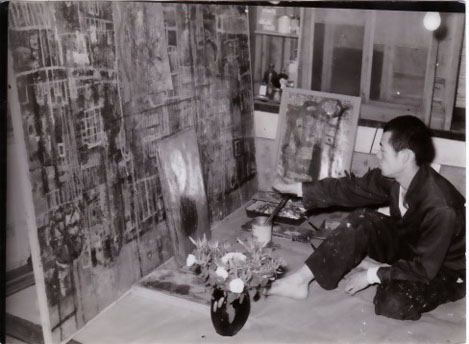
1951
神戸市立須佐野中学校入学
叔父堀尾幹雄に絵、書の才能を認められる。叔父は民芸運動に関わり後に大阪民芸協会理事となった。敬愛する叔父との対話、旅行、朝鮮日本民芸の膨大なコレクションに深い影響を受けた。
神戸市立須佐野中学校入学
叔父堀尾幹雄に絵、書の才能を認められる。叔父は民芸運動に関わり後に大阪民芸協会理事となった。敬愛する叔父との対話、旅行、朝鮮日本民芸の膨大なコレクションに深い影響を受けた。
1955
中学卒業後、家計を支える為に三菱重工業神戸造船所に就職。主に製造部門で定年まで勤める。
大企業の”有難さ”で残業をせずに必ず定時で帰り、休暇は全部取り、通勤時間は自転車で十数分の近さであり(上下ジージャンを着て自転車上で歌をうたったり、ハーモニカを吹きながら通勤)
会社以外の時間はすべて美術に費やした。役職昇進試験の用紙に「エラクなりたくない」と記入し最後まで平社員であった。
造船所の洋画部CPMに属し、写生、デッサンを楽しみ終生具象抽象のへだたりなく絵を描き発表した。
中学卒業後、家計を支える為に三菱重工業神戸造船所に就職。主に製造部門で定年まで勤める。
大企業の”有難さ”で残業をせずに必ず定時で帰り、休暇は全部取り、通勤時間は自転車で十数分の近さであり(上下ジージャンを着て自転車上で歌をうたったり、ハーモニカを吹きながら通勤)
会社以外の時間はすべて美術に費やした。役職昇進試験の用紙に「エラクなりたくない」と記入し最後まで平社員であった。
造船所の洋画部CPMに属し、写生、デッサンを楽しみ終生具象抽象のへだたりなく絵を描き発表した。
1957 (18歳)
第10回芦屋市展に入選(以後連続出品)。吉原治良と出会う
第10回芦屋市展に入選(以後連続出品)。吉原治良と出会う
1960年代
「電停シリーズ」神戸市電(路面電車)の全停留所を写生した。
「電停シリーズ」神戸市電(路面電車)の全停留所を写生した。
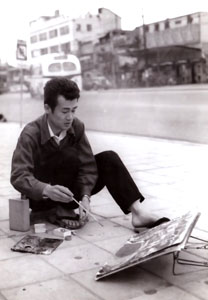
1965 (26歳)
第15回具体美術展(グタイピナコテカ 大阪)初出品
1972年具体解散まで連続出品
第15回具体美術展(グタイピナコテカ 大阪)初出品
1972年具体解散まで連続出品
1966 (27歳)
初個展 信濃橋画廊(大阪) 堀尾の良き理解者であった美術評論家高橋亨の企画による。
具体美術協会会員となる
初個展 信濃橋画廊(大阪) 堀尾の良き理解者であった美術評論家高橋亨の企画による。
具体美術協会会員となる
1968 (29歳)
グタイピナコテカ個展
具体展に出品していた木村昭子と結婚(一男一女生まれる)
グタイピナコテカ個展
具体展に出品していた木村昭子と結婚(一男一女生まれる)
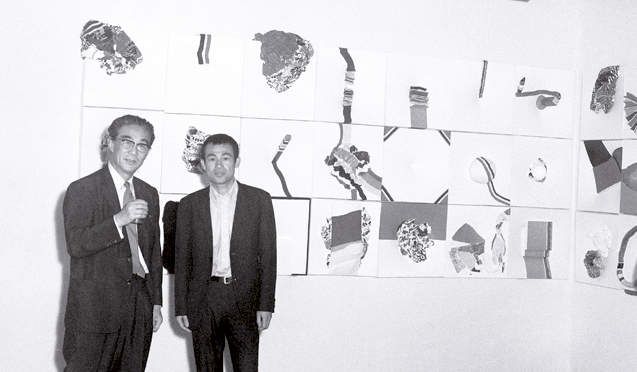
1973 (34歳)
京都北白川美術村で、美術村住人で具体会員の坂本昌也と制作、発表。美術村にはしばしば宿泊し、住人美術家達との交流を楽しんだ。
京都北白川美術村で、美術村住人で具体会員の坂本昌也と制作、発表。美術村にはしばしば宿泊し、住人美術家達との交流を楽しんだ。
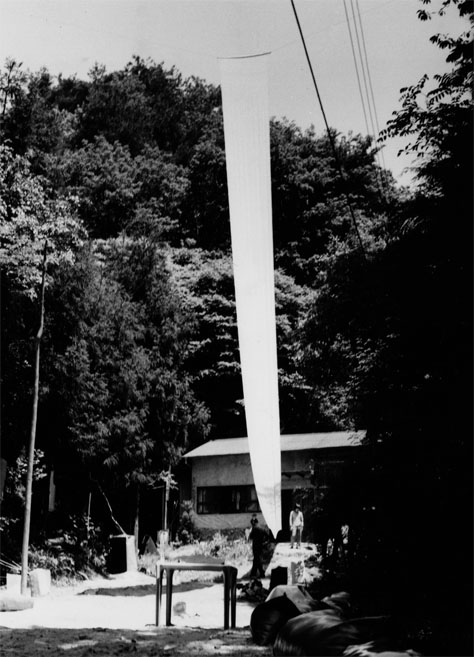
1975 (36歳)
居酒屋「ぼんくら」(神戸)での作品展示がはじまる
居酒屋「ぼんくら」(神戸)での作品展示がはじまる
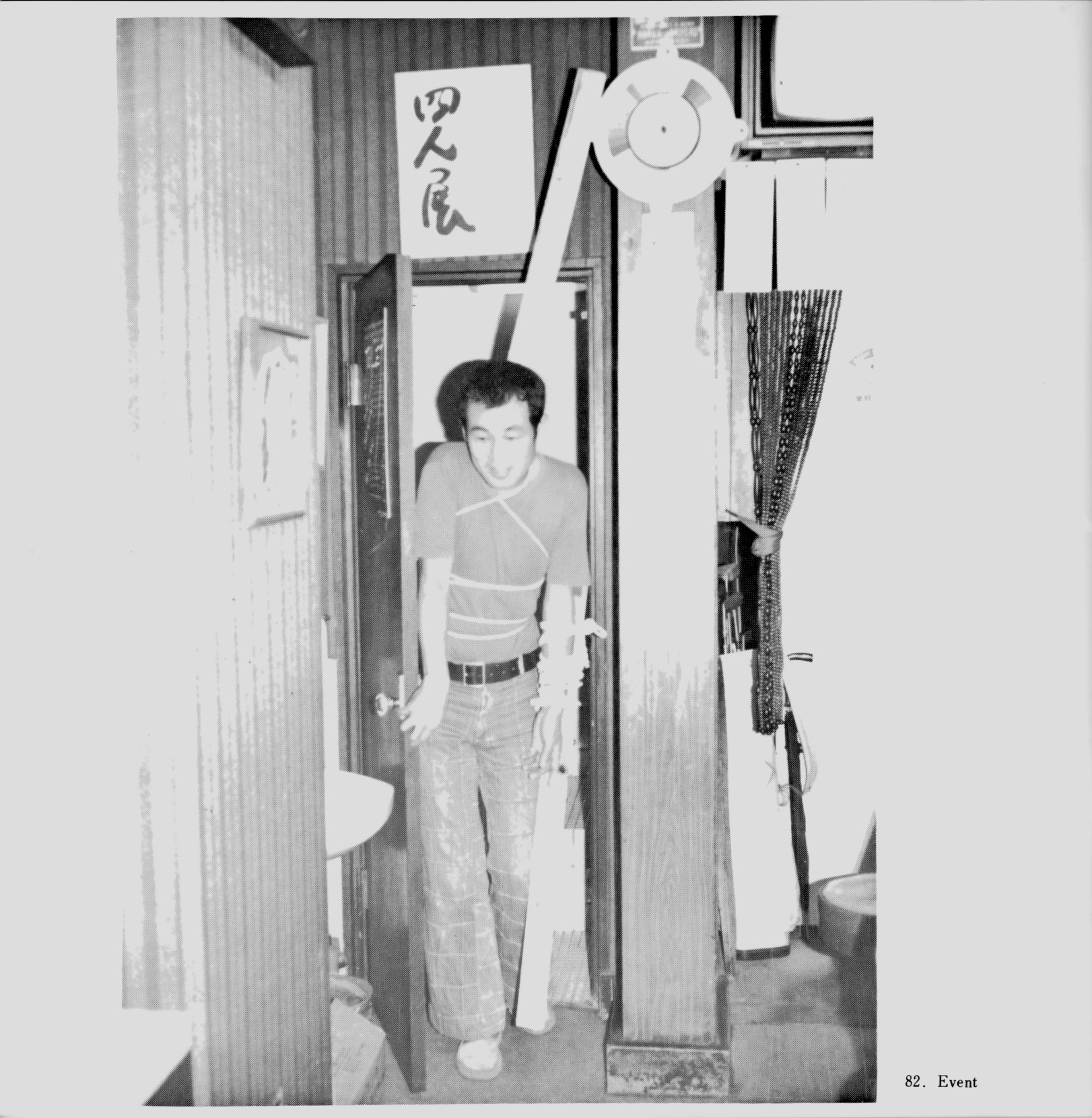
1979 (40歳)
竹中省己(画家 唵よしみ)から相談を受け、神戸三宮東門筋に東門画廊を開設。
1985年の閉廊まで、独自の路線を貫き、新しい画廊の在り方を提示した。途中、独断、マンネリ、堀尾の会社出向による不在など、挫折、停滞も経験しつつ、数多くの実験的、意欲的な個展、グループ展が行われた。管理をしていた古道具屋「生田ギャラリー」の理解なくしては不可能であった
竹中省己(画家 唵よしみ)から相談を受け、神戸三宮東門筋に東門画廊を開設。
1985年の閉廊まで、独自の路線を貫き、新しい画廊の在り方を提示した。途中、独断、マンネリ、堀尾の会社出向による不在など、挫折、停滞も経験しつつ、数多くの実験的、意欲的な個展、グループ展が行われた。管理をしていた古道具屋「生田ギャラリー」の理解なくしては不可能であった
1980 (41歳)
三菱重工名古屋航空機制作所に出向中、BOX Gallery(名古屋)で個展「同時空間Black Paint」を行い、関西在住の友人に、それぞれの居場所での”ブラックペイント”を依頼。以後「空気」「同時空間」のテーマは続けられた。
1980年代は、職場でのストレス、美術界へのコンプレックス、身体不調などで、しばしば精神不安定となった。粗忽による怪我も多く入院することもあった。
三菱重工名古屋航空機制作所に出向中、BOX Gallery(名古屋)で個展「同時空間Black Paint」を行い、関西在住の友人に、それぞれの居場所での”ブラックペイント”を依頼。以後「空気」「同時空間」のテーマは続けられた。
1980年代は、職場でのストレス、美術界へのコンプレックス、身体不調などで、しばしば精神不安定となった。粗忽による怪我も多く入院することもあった。
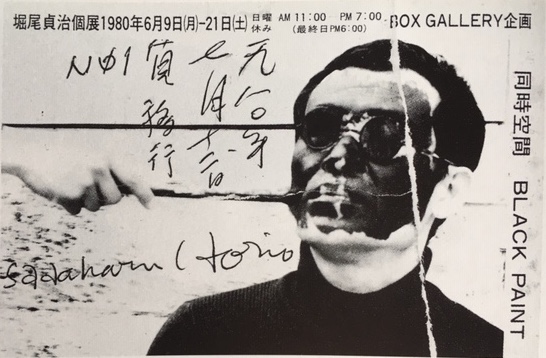
1982 (43歳)
アートスペース虹(京都)第一回個展。
1985年以降は閉廊する2017年まで、年初に連続個展。
アートスペース虹(京都)第一回個展。
1985年以降は閉廊する2017年まで、年初に連続個展。
1984 (45歳)
アートスペース虹 熊谷寿美子企画により、楠華殿(京都東山区)の襖絵制作、以後友人親戚宅の襖、壁に多くの書画を描いた。又、自身の展覧会、パフォーマンスをはじめ、大小自他を問わず集会のために垂れ幕を大書するのが常で、依頼でボランティア活動ののぼり、パネル、デモの横断幕反戦集会の看板等、無数の「一回限りの書」を書いた。
アートスペース虹 熊谷寿美子企画により、楠華殿(京都東山区)の襖絵制作、以後友人親戚宅の襖、壁に多くの書画を描いた。又、自身の展覧会、パフォーマンスをはじめ、大小自他を問わず集会のために垂れ幕を大書するのが常で、依頼でボランティア活動ののぼり、パネル、デモの横断幕反戦集会の看板等、無数の「一回限りの書」を書いた。
1985 (46歳)
急性白内障の為、左目水晶体摘出手術を行う。
両眼失明の恐れもあった。失明しても可能な制作行為として様々な物体に1日1色絵具を塗ることを始める。「色塗り」は死の前日まで、1日も欠かさず続けられた。
東門画廊の個展で、はじめて「あたりまえのこと」というタイトルを用いる。東門画廊が閉廊し、そのあとを継ぐ形で同じく竹中省己所有の歯科医院階下のうどん屋を改装して六間画廊開設。神戸市長田区のこてこての下町商店街にあった、再開発に伴う建物取り壊しの為3年後に閉廊
急性白内障の為、左目水晶体摘出手術を行う。
両眼失明の恐れもあった。失明しても可能な制作行為として様々な物体に1日1色絵具を塗ることを始める。「色塗り」は死の前日まで、1日も欠かさず続けられた。
東門画廊の個展で、はじめて「あたりまえのこと」というタイトルを用いる。東門画廊が閉廊し、そのあとを継ぐ形で同じく竹中省己所有の歯科医院階下のうどん屋を改装して六間画廊開設。神戸市長田区のこてこての下町商店街にあった、再開発に伴う建物取り壊しの為3年後に閉廊
1986 (47歳)
三菱重工の子会社「リョーイン」に出向。印刷会社であり業務として取得した製本技術が自身の作品、資料などの記録に大いに役立った。
同僚として周治央城と出会う。絵師堀尾、彫師周治、二人で刷る墨木版画は風景にはじまり、大判「妙好人伝」シリーズ150点、震災風景等が次々と制作発表された。
三菱重工の子会社「リョーイン」に出向。印刷会社であり業務として取得した製本技術が自身の作品、資料などの記録に大いに役立った。
同僚として周治央城と出会う。絵師堀尾、彫師周治、二人で刷る墨木版画は風景にはじまり、大判「妙好人伝」シリーズ150点、震災風景等が次々と制作発表された。

1987 (48歳)
神戸国際交流館(神戸ポートアイランド)に画廊ポルティコがオープン。神戸市文化振興財団から運営を委託される。東門画廊と同様に観客の少ないギャラリーで、会期中は作家が会場を自主管理しなければならない場所であったが、広大なスペースを使って、真摯な意欲あふれる展示が続いた。1995年阪神淡路大震災で閉廊。
神戸国際交流館(神戸ポートアイランド)に画廊ポルティコがオープン。神戸市文化振興財団から運営を委託される。東門画廊と同様に観客の少ないギャラリーで、会期中は作家が会場を自主管理しなければならない場所であったが、広大なスペースを使って、真摯な意欲あふれる展示が続いた。1995年阪神淡路大震災で閉廊。
1989 (50歳)
六間画廊で堀尾貞治作品をみて、ぼんくらを訪れた山下克彦と出会う、以後山下は、ほぼすべての堀尾の展覧会、パフォーマンスをサポートし記録する。1993年から、堀尾宅に毎日郵送された「SADA」とそれに対する堀尾の返信は、堀尾の死まで続いた。
六間画廊で堀尾貞治作品をみて、ぼんくらを訪れた山下克彦と出会う、以後山下は、ほぼすべての堀尾の展覧会、パフォーマンスをサポートし記録する。1993年から、堀尾宅に毎日郵送された「SADA」とそれに対する堀尾の返信は、堀尾の死まで続いた。
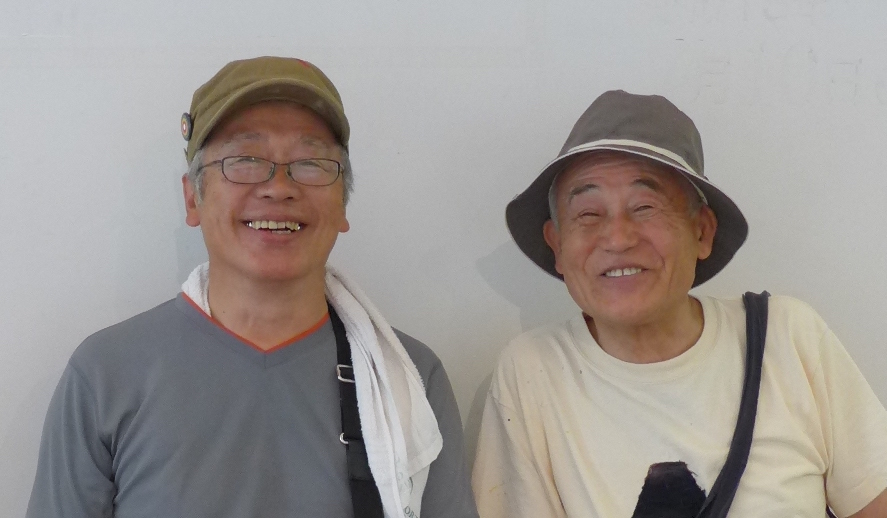
1992 (53歳)
神戸市灘区阪急電車高架下に清水公明がギャラリー2001(2006年からアトリエ2001)をオープン。独自のアートを追求する作家たちの発表の場となる。過激な展示、パフォーマンスも許容する自由な空間で、「ぼんくら」「空気」のメンバーや堀尾にとっても神戸における主要な発表の場であった。
1993年から2000年まで毎年12月に個展。
神戸市灘区阪急電車高架下に清水公明がギャラリー2001(2006年からアトリエ2001)をオープン。独自のアートを追求する作家たちの発表の場となる。過激な展示、パフォーマンスも許容する自由な空間で、「ぼんくら」「空気」のメンバーや堀尾にとっても神戸における主要な発表の場であった。
1993年から2000年まで毎年12月に個展。
1995 (56歳)
阪神淡路大震災。自宅は部分損壊で住むことは出来たが、家の中はガレキ状態となった。余震が続き日常生活がうばわれた中、叔父堀尾幹雄から震災風景を描いておくよう言われる。葛藤の中で描きはじめた震災風景画は震災後から現在まで、学校、役所、寺院、美術館、画廊等で展示され続けている。
全壊した居酒屋ぼんくらを松本剛太郎設計で、仲間と木造手作りで再建
ナノ・リウム(山梨)で個展、以降2018年まで山下克彦と毎年個展。
2000年から2009年まで 富士吉田市政50周年記念「『まち』がミュージアム」に現場芸術集団「空気」で参加
阪神淡路大震災。自宅は部分損壊で住むことは出来たが、家の中はガレキ状態となった。余震が続き日常生活がうばわれた中、叔父堀尾幹雄から震災風景を描いておくよう言われる。葛藤の中で描きはじめた震災風景画は震災後から現在まで、学校、役所、寺院、美術館、画廊等で展示され続けている。
全壊した居酒屋ぼんくらを松本剛太郎設計で、仲間と木造手作りで再建
ナノ・リウム(山梨)で個展、以降2018年まで山下克彦と毎年個展。
2000年から2009年まで 富士吉田市政50周年記念「『まち』がミュージアム」に現場芸術集団「空気」で参加
1997 (58歳)
「1分打法」を始める。毎朝起床後、アトリエの床に10枚程度の紙を並べ、一枚1分(実際には1分かからなかった)の速さで絵を描く。死の前日まで続く
「1分打法」を始める。毎朝起床後、アトリエの床に10枚程度の紙を並べ、一枚1分(実際には1分かからなかった)の速さで絵を描く。死の前日まで続く
1998 (59歳)
三菱重工神戸造船所を定年退職。以後すべての時間を美術に充て、年間100余の個展グループ展を行う
三菱重工神戸造船所を定年退職。以後すべての時間を美術に充て、年間100余の個展グループ展を行う
2002 (63歳)
芦屋市立美術博物館(兵庫県)で初の美術館での個展、38日間の会期中毎日パフォーマンスを行い、会場の展示はめまぐるしく変わった。
美術館を訪れた原口研治と出会う、以後原口は堀尾の海外の展覧会、パフォーマンスに同行サポートし、現場芸術集団「空気」の事務局長を務めた。
芦屋市立美術博物館(兵庫県)で初の美術館での個展、38日間の会期中毎日パフォーマンスを行い、会場の展示はめまぐるしく変わった。
美術館を訪れた原口研治と出会う、以後原口は堀尾の海外の展覧会、パフォーマンスに同行サポートし、現場芸術集団「空気」の事務局長を務めた。
2003 (64歳)
兵庫運河貯木場(神戸市兵庫区)で野外展「空気美術館」開催。堀尾と交流のあったアーティスト達が参加し約一年間作品展示とパフォーマンスを行う、これを契機として現場芸術集団「空気」が誕生した。
兵庫運河貯木場(神戸市兵庫区)で野外展「空気美術館」開催。堀尾と交流のあったアーティスト達が参加し約一年間作品展示とパフォーマンスを行う、これを契機として現場芸術集団「空気」が誕生した。
2008 (69歳)
神戸市の区画整理のため自宅アトリエを解体する際に空っぽになった建物の内外いたる所にぼんくらメンバーが黒の点を書き住居は大きいオブジェとなった。
神戸市の区画整理のため自宅アトリエを解体する際に空っぽになった建物の内外いたる所にぼんくらメンバーが黒の点を書き住居は大きいオブジェとなった。
2011 (72歳)
ベルギーのアートディレクター、コレクターのアクセル・ヴェルヴォルトのギャラリー(アントワープ)で個展、作品集刊行。以後アクセル企画の個展、パフォーマンスがアントワープ、ブリュッセル、ベネチア、ニューヨーク、香港で行われた。
ベルギーのアートディレクター、コレクターのアクセル・ヴェルヴォルトのギャラリー(アントワープ)で個展、作品集刊行。以後アクセル企画の個展、パフォーマンスがアントワープ、ブリュッセル、ベネチア、ニューヨーク、香港で行われた。
2016 (77歳)
喜多ギャラリー(奈良額田部)で1000枚のパネル作品「千Go千点物語」制作
2016年頃よりメニエール病発症、服薬を続けるが治療に必須の安静をとることが出来ず、医師に警告されながらも走り続けた
喜多ギャラリー(奈良額田部)で1000枚のパネル作品「千Go千点物語」制作
2016年頃よりメニエール病発症、服薬を続けるが治療に必須の安静をとることが出来ず、医師に警告されながらも走り続けた
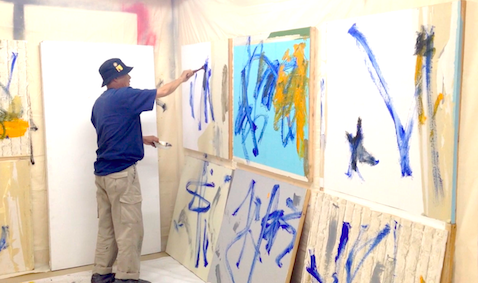
2018 (79歳)
病状が次第に悪化し、難聴、耳鳴り、不眠に苦しんで生涯4度目の鬱状態となる。鬱による突発性記憶障害に自ら大きい衝撃を受ける。
11月3日自宅近くにあり、少年時代の遊び場で1970年代から作品展示、パフォーマンスを数多く行った兵庫運河貯木場跡で自死。
病状が次第に悪化し、難聴、耳鳴り、不眠に苦しんで生涯4度目の鬱状態となる。鬱による突発性記憶障害に自ら大きい衝撃を受ける。
11月3日自宅近くにあり、少年時代の遊び場で1970年代から作品展示、パフォーマンスを数多く行った兵庫運河貯木場跡で自死。
Sadaharu Horio Chronology Edited by Akiko Horio
1939 (age 0)
April 5: Sadaharu Horio is born in the working-class neighborhood of Kobe’s Hyogo Ward, where he lives for the rest of his life. During the Pacific War, he is temporarily evacuated to his father’s hometown, a mountain village in Tottori headed by the Horio family. After the war, Horio’s father is incarcerated for three months in Sugamo Prison for working as a military photographer. He later becomes a photographer at the Kobe Shimbun newspaper, and is a strict disciplinarian with his children. Horio is the eldest of four siblings, three boys and one girl.
April 5: Sadaharu Horio is born in the working-class neighborhood of Kobe’s Hyogo Ward, where he lives for the rest of his life. During the Pacific War, he is temporarily evacuated to his father’s hometown, a mountain village in Tottori headed by the Horio family. After the war, Horio’s father is incarcerated for three months in Sugamo Prison for working as a military photographer. He later becomes a photographer at the Kobe Shimbun newspaper, and is a strict disciplinarian with his children. Horio is the eldest of four siblings, three boys and one girl.
1945 (age 6)
Enters Kobe Municipal Hamayama Elementary School. After meeting the art teacher Tokumitsu Kioka, Horio decides to“do art for my whole life.”He remains in touch with Kioka until the teacher’s death.
Enters Kobe Municipal Hamayama Elementary School. After meeting the art teacher Tokumitsu Kioka, Horio decides to“do art for my whole life.”He remains in touch with Kioka until the teacher’s death.

1951 (age 12)
Enters Kobe Municipal Susano Junior High School. Horio’s uncle, Mikio, recognizes his gift for painting and calligraphy. After becoming involved with the Mingei folk art movement, Mikio serves as director of the Osaka Mingei Association. Horio is deeply influenced by his conversations and trips with his beloved uncle as well as Mikio’s huge collection of Korean and Japanese folk art.
Enters Kobe Municipal Susano Junior High School. Horio’s uncle, Mikio, recognizes his gift for painting and calligraphy. After becoming involved with the Mingei folk art movement, Mikio serves as director of the Osaka Mingei Association. Horio is deeply influenced by his conversations and trips with his beloved uncle as well as Mikio’s huge collection of Korean and Japanese folk art.
1955 (age 16)
After graduating from junior high school, Horio finds a job in the Kobe Shipyard of Mitsubishi Heavy Industries to help support his family. He works in the company’s production division until retirement.
Thanks to this position at a large corporation, he never works overtime, goes home at a fixed time, and takes all of his vacation time. He also lives so near to the shipyard that he can commute to work by bicycle in about ten minutes. (Dressed in jeans and a denim jacket, he sings or plays the harmonica as he rides his bicycle.)
While working on a project to develop Mitsubishi’s airplane manufacturing division in Nagoya, Horio holds an exhibition called Dojikukan Black Paint (the title means“synchronized spaces”) at the city’s Box Gallery. He asks his Kansai- based friends to apply“black paint”in various places. He later continues to pursue the themes of“air”and“synchronized spaces.”
When he is not working, Horio uses all of his time to make art. After writing“I don’t want to move up”on an application for a promotional examination, he spends his entire working life as a rank-and-file employee.
In the 1980s, Horio sometimes suffers from emotional imbalances due to stress at work, a sense of inferiority in the art world, and physical complaints. He was also occasionally hospitalized due to numerous careless injuries.
Horio joins the company’s Western-style painting club CPM. He enjoys sketching from life and drawing, and devotes equal time to figurative and abstract pictures throughout his life.
After graduating from junior high school, Horio finds a job in the Kobe Shipyard of Mitsubishi Heavy Industries to help support his family. He works in the company’s production division until retirement.
Thanks to this position at a large corporation, he never works overtime, goes home at a fixed time, and takes all of his vacation time. He also lives so near to the shipyard that he can commute to work by bicycle in about ten minutes. (Dressed in jeans and a denim jacket, he sings or plays the harmonica as he rides his bicycle.)
While working on a project to develop Mitsubishi’s airplane manufacturing division in Nagoya, Horio holds an exhibition called Dojikukan Black Paint (the title means“synchronized spaces”) at the city’s Box Gallery. He asks his Kansai- based friends to apply“black paint”in various places. He later continues to pursue the themes of“air”and“synchronized spaces.”
When he is not working, Horio uses all of his time to make art. After writing“I don’t want to move up”on an application for a promotional examination, he spends his entire working life as a rank-and-file employee.
In the 1980s, Horio sometimes suffers from emotional imbalances due to stress at work, a sense of inferiority in the art world, and physical complaints. He was also occasionally hospitalized due to numerous careless injuries.
Horio joins the company’s Western-style painting club CPM. He enjoys sketching from life and drawing, and devotes equal time to figurative and abstract pictures throughout his life.
1957 (age 18)
Horio’s work is selected for the 10th Ashiya City Exhibition (continues to show in successive editions of the event). Meets Jiro Yoshihara, the leader of the Gutai Art Association.
Horio’s work is selected for the 10th Ashiya City Exhibition (continues to show in successive editions of the event). Meets Jiro Yoshihara, the leader of the Gutai Art Association.
1960s
Horio makes the Tram Stop Series, a group of sketches of all the stops on the Kobe City Tram.
Horio makes the Tram Stop Series, a group of sketches of all the stops on the Kobe City Tram.

1965 (age 26)
Shows his work for the first time in the 15th Gutai Art Exhibition, held at the Gutai Pinacotheca in Osaka. Continues to show with the group until Gutai’s dissolution in 1972.
Shows his work for the first time in the 15th Gutai Art Exhibition, held at the Gutai Pinacotheca in Osaka. Continues to show with the group until Gutai’s dissolution in 1972.
1966 (age 27)
Holds his first solo show at Shinanobashi Gallery in Osaka. The show is organized by the art critic Toru Takahashi, a great supporter of Horio’s work.
Becomes a member of the Gutai group.
Holds his first solo show at Shinanobashi Gallery in Osaka. The show is organized by the art critic Toru Takahashi, a great supporter of Horio’s work.
Becomes a member of the Gutai group.
1968 (age 29)
Holds a solo show at the Gutai Pinacotheca.
Marries Akiko Kimura, an artist who showed her work in a Gutai exhibition, at the Gutai Pinacotheca. The couple later have two children, one boy and one girl.
Holds a solo show at the Gutai Pinacotheca.
Marries Akiko Kimura, an artist who showed her work in a Gutai exhibition, at the Gutai Pinacotheca. The couple later have two children, one boy and one girl.

1973 (age 34)
Makes and shows work with the Gutai artist Masaya Sakamoto at Kyoto Kita-Shirakawa Art Village, where Sakamoto lives. Horio frequently stays at the village, and develops friendships with the resident artists.
Makes and shows work with the Gutai artist Masaya Sakamoto at Kyoto Kita-Shirakawa Art Village, where Sakamoto lives. Horio frequently stays at the village, and develops friendships with the resident artists.

1975 (age 36)
Holds his first show at the Bonkura bar in Kobe.
Holds his first show at the Bonkura bar in Kobe.

1979 (age 40)
Opens Higashimon Gallery on the second floor of an udon noodle shop on Higashimon-suji in Kobe after being consulted by Yoshimi Takenaka (aka the painter Yoshimi On).
Until the gallery closes in 1985, Horio consistently pursues a unique path and leads the way for a new kind of gallery. Over the years, Horio faces setbacks and stagnation at the gallery due to making arbitrary decisions, periodically falling in a rut, and being absent temporarily for work assignments, but he holds numerous ambitious and experimental, solo and group exhibitions. This would never have been possible without the understanding of his landlord, the owner of an antique shop called Ikuta Gallery, but he was frequently scolded by his downstairs neighbor at the noodle shop.
Opens Higashimon Gallery on the second floor of an udon noodle shop on Higashimon-suji in Kobe after being consulted by Yoshimi Takenaka (aka the painter Yoshimi On).
Until the gallery closes in 1985, Horio consistently pursues a unique path and leads the way for a new kind of gallery. Over the years, Horio faces setbacks and stagnation at the gallery due to making arbitrary decisions, periodically falling in a rut, and being absent temporarily for work assignments, but he holds numerous ambitious and experimental, solo and group exhibitions. This would never have been possible without the understanding of his landlord, the owner of an antique shop called Ikuta Gallery, but he was frequently scolded by his downstairs neighbor at the noodle shop.
1980 (age 41)
While working on a project to develop Mitsubishi’s airplane manufacturing division in Nagoya, Horio holds an exhibition called Dojikukan Black Paint (the title means“synchronized spaces”) at the city’s Box Gallery. He asks his Kansai- based friends to apply“black paint”in various places. He later continues to pursue the themes of“air”and“synchronized spaces.”
In the 1980s, Horio sometimes suffers from emotional imbalances due to stress at work, a sense of inferiority in the art world, and physical complaints. He was also occasionally hospitalized due to numerous careless injuries.
While working on a project to develop Mitsubishi’s airplane manufacturing division in Nagoya, Horio holds an exhibition called Dojikukan Black Paint (the title means“synchronized spaces”) at the city’s Box Gallery. He asks his Kansai- based friends to apply“black paint”in various places. He later continues to pursue the themes of“air”and“synchronized spaces.”
In the 1980s, Horio sometimes suffers from emotional imbalances due to stress at work, a sense of inferiority in the art world, and physical complaints. He was also occasionally hospitalized due to numerous careless injuries.

1982 (age 43)
Holds his first exhibition at Art Space Niji in Kyoto. From 1985 until the gallery closes in 2017, Horio holds a series of solo exhibitions at the venue at the beginning of each year.
Holds his first exhibition at Art Space Niji in Kyoto. From 1985 until the gallery closes in 2017, Horio holds a series of solo exhibitions at the venue at the beginning of each year.
1984 (age 45)
As part of a project organized by Sumiko Kumagai, the owner of Art Space Niji, Horio makes fusuma paintings for Kusunokikaden, a venue for weddings, in Kyoto’s Higashiyama district. He subsequently made calligraphy for fusuma and walls in the houses of friends and relatives. Horio also regularly made one- time-only calligraphy for large banners for events of all sizes, including his own exhibitions and performances, and accepts commissions to make flags for volunteer activities, panels, and signs for anti-war demonstrations.
As part of a project organized by Sumiko Kumagai, the owner of Art Space Niji, Horio makes fusuma paintings for Kusunokikaden, a venue for weddings, in Kyoto’s Higashiyama district. He subsequently made calligraphy for fusuma and walls in the houses of friends and relatives. Horio also regularly made one- time-only calligraphy for large banners for events of all sizes, including his own exhibitions and performances, and accepts commissions to make flags for volunteer activities, panels, and signs for anti-war demonstrations.
1985 (age 46)
急After being diagnosed with an acute cataract, Horio undergoes an operation on his left eye. There is a risk that he might lose his eyesight in both eyes. Thinking that he wants to continue making his work even if he loses his vision, Horio begins applying one color of paint a day to a variety of objects. He continues this project without missing a single day until the day before he dies.
Makes use of the title Atarimae-no-koto for the first time in a solo show at Higashimon Gallery. The gallery later closes, but Horio carries on the idea by opening Rokken Gallery in a repurposed udon noodle shop downstairs from a dentist’s office in a building owned by Yoshimi Takenaka. The gallery, located in a bustling shopping district in Kobe’s working-class Nagata Ward, closes three years later when Takenaka dies.
急After being diagnosed with an acute cataract, Horio undergoes an operation on his left eye. There is a risk that he might lose his eyesight in both eyes. Thinking that he wants to continue making his work even if he loses his vision, Horio begins applying one color of paint a day to a variety of objects. He continues this project without missing a single day until the day before he dies.
Makes use of the title Atarimae-no-koto for the first time in a solo show at Higashimon Gallery. The gallery later closes, but Horio carries on the idea by opening Rokken Gallery in a repurposed udon noodle shop downstairs from a dentist’s office in a building owned by Yoshimi Takenaka. The gallery, located in a bustling shopping district in Kobe’s working-class Nagata Ward, closes three years later when Takenaka dies.
1986 (age 47)
Horio is transferred to Ryoin, a Kobe subsidiary of Mitsubishi Heavy Industries. The bookbinding techniques that he learns at the printing company prove to be of great use in documenting his work and related materials.
Meets Hisaki Shuji, a coworker at the company. Together the two produce a succession of sumi ink prints, with Horio overseeing the painting, and Shuji the woodblock carving. These works include landscapes, a large-format series of 150 pieces called Myokonin-den (devout followers of the Jodo Shinshu sect of Buddhism), and scenes from the Kobe earthquake.
Horio is transferred to Ryoin, a Kobe subsidiary of Mitsubishi Heavy Industries. The bookbinding techniques that he learns at the printing company prove to be of great use in documenting his work and related materials.
Meets Hisaki Shuji, a coworker at the company. Together the two produce a succession of sumi ink prints, with Horio overseeing the painting, and Shuji the woodblock carving. These works include landscapes, a large-format series of 150 pieces called Myokonin-den (devout followers of the Jodo Shinshu sect of Buddhism), and scenes from the Kobe earthquake.

1987 (age 48)
At the opening of Gallery Portico in the Kobe International Conference Center on the city’s Port Island, Horio receives a management commission from the Kobe Cultural Foundation. As with Higashimon Gallery, the gallery only attracts a small audience, and the artists have to manage the venue themselves during exhibitions. Despite this, he organizes events that are extremely earnest and ambitious in the expansive space. The gallery closes following the Great Hanshin- Awaji Earthquake in 1995.
At the opening of Gallery Portico in the Kobe International Conference Center on the city’s Port Island, Horio receives a management commission from the Kobe Cultural Foundation. As with Higashimon Gallery, the gallery only attracts a small audience, and the artists have to manage the venue themselves during exhibitions. Despite this, he organizes events that are extremely earnest and ambitious in the expansive space. The gallery closes following the Great Hanshin- Awaji Earthquake in 1995.
1989 (age 50)
Meets Katsuhiko Yamashita, who visits the Bonkura bar after seeing Horio’s work at Rokken Gallery. Yamashita subsequent assists and documents nearly all of Horio’s exhibitions and performances. From 1993 until Horio’s death, Yamashita sends a series of photographs called Sada to Horio’s house everyday and the artist responds to it.
Meets Katsuhiko Yamashita, who visits the Bonkura bar after seeing Horio’s work at Rokken Gallery. Yamashita subsequent assists and documents nearly all of Horio’s exhibitions and performances. From 1993 until Horio’s death, Yamashita sends a series of photographs called Sada to Horio’s house everyday and the artist responds to it.

1992 (age 53)
Masaaki Shimizu opens Gallery 2001 (changed to Atelier 2001 in 2006) under the Hankyu Railway tracks in Kobe’s Nada Ward. The venue showcases works by artists who are pursuing unique forms of art. This free space, which permits extreme exhibitions and performances, becomes a highly significant Kobe venue for the members of Bonkura and the On-site Art Squad“Kuki”as well as Horio himself. Horio holds an annual solo show there every December from 1993 to 2000.
Masaaki Shimizu opens Gallery 2001 (changed to Atelier 2001 in 2006) under the Hankyu Railway tracks in Kobe’s Nada Ward. The venue showcases works by artists who are pursuing unique forms of art. This free space, which permits extreme exhibitions and performances, becomes a highly significant Kobe venue for the members of Bonkura and the On-site Art Squad“Kuki”as well as Horio himself. Horio holds an annual solo show there every December from 1993 to 2000.
1995 (age 56)
The Great Hanshin-Awaji Earthquake strikes the Kobe area. Horio’s house is partially destroyed, but remains livable despite the rubble. As continual aftershocks make it impossible to live regularly, Horio’s uncle Mikio suggests that create pictures of the quake. The resulting pictures, which he initially struggles to make, have continually been shown at schools, public offices, temples, museums, galleries, and other places over the years.
The Bonkura bar, which was completely destroyed in the quake, is reconstructed by Horio and his friends out of wood based on a design by Gotaro Matsumoto.
Holds a solo show at Gallery Nano-Rium in Fujiyoshida, Yamanashi Prefecture, marking the start of a series of annual exhibitions with Katsuhiko Yamashita at the venue that continues until 2018.
From 2000 to 2009, participates every year in the Machi ga museum (Town Is a Museum) exhibition held in Fujiyoshida to commemorate the town’s 50th anniversary (from 2007 to 2009, participates under the name Sadaharu Horio and On- site Art Squad“Kuki”).
The Great Hanshin-Awaji Earthquake strikes the Kobe area. Horio’s house is partially destroyed, but remains livable despite the rubble. As continual aftershocks make it impossible to live regularly, Horio’s uncle Mikio suggests that create pictures of the quake. The resulting pictures, which he initially struggles to make, have continually been shown at schools, public offices, temples, museums, galleries, and other places over the years.
The Bonkura bar, which was completely destroyed in the quake, is reconstructed by Horio and his friends out of wood based on a design by Gotaro Matsumoto.
Holds a solo show at Gallery Nano-Rium in Fujiyoshida, Yamanashi Prefecture, marking the start of a series of annual exhibitions with Katsuhiko Yamashita at the venue that continues until 2018.
From 2000 to 2009, participates every year in the Machi ga museum (Town Is a Museum) exhibition held in Fujiyoshida to commemorate the town’s 50th anniversary (from 2007 to 2009, participates under the name Sadaharu Horio and On- site Art Squad“Kuki”).
1997 (age 58)
Begins the Ippun-daho (One-Minute Paintings) series. Every morning after getting up, Horio spreads about ten sheets of paper across the floor of his studio and paints pictures at a speed of one per minute (they actually take even less time). Horio continues the series until the day before his death.
Begins the Ippun-daho (One-Minute Paintings) series. Every morning after getting up, Horio spreads about ten sheets of paper across the floor of his studio and paints pictures at a speed of one per minute (they actually take even less time). Horio continues the series until the day before his death.
1998 (age 59)
Retires from Mitsubishi Heavy Industries. Now able to devote all of his time to art, Horio begins showing his work in 100 solo and group exhibitions every year.
Retires from Mitsubishi Heavy Industries. Now able to devote all of his time to art, Horio begins showing his work in 100 solo and group exhibitions every year.
2002 (age 63)
Holds his first museum-scale solo show at the Ashiya City Museum of Art & History in Hyogo Prefecture. Horio stages a performance every day during the 38-day event, transforming the exhibition at a dizzying pace.
Meets Kenji Haraguchi during his visit to the museum. Haraguchi subsequently accompanies Horio and provides support for his foreign exhibitions and performances while also becoming the director-general of Kuki.
Holds his first museum-scale solo show at the Ashiya City Museum of Art & History in Hyogo Prefecture. Horio stages a performance every day during the 38-day event, transforming the exhibition at a dizzying pace.
Meets Kenji Haraguchi during his visit to the museum. Haraguchi subsequently accompanies Horio and provides support for his foreign exhibitions and performances while also becoming the director-general of Kuki.
2003 (age 64)
Holds an outdoor exhibition called Museum of the Air at the Hyogo Canal Lumberyard (Hyogo Ward, Kobe). Horio and a number of artists associated with him exhibit their works and stage performances for approximately one year. This leads to the formation of the On-site Art Squad“Kuki.”
Holds an outdoor exhibition called Museum of the Air at the Hyogo Canal Lumberyard (Hyogo Ward, Kobe). Horio and a number of artists associated with him exhibit their works and stage performances for approximately one year. This leads to the formation of the On-site Art Squad“Kuki.”
2008 (age 69)
Forced to dismantle his home studio due to a city rezoning project, Horio and the Bonkura members paint black dots all over the inside and outside of the empty building, turning the house into a huge art object.
Forced to dismantle his home studio due to a city rezoning project, Horio and the Bonkura members paint black dots all over the inside and outside of the empty building, turning the house into a huge art object.
2011 (age 72)
Holds a solo show at the Belgian art director and collector Axel Vervoordt’s gallery in Antwerp. A collection of his work is also published. Vervoordt subsequently organizes solo shows and performances for Horio in Antwerp, Brussels, Venice, New York, and Hong Kong.
Holds a solo show at the Belgian art director and collector Axel Vervoordt’s gallery in Antwerp. A collection of his work is also published. Vervoordt subsequently organizes solo shows and performances for Horio in Antwerp, Brussels, Venice, New York, and Hong Kong.
2016 (age 77)
Makes A Tale of 1000 GO 1000 Pictures, a work consisting of 1,000 panels, at Kita Gallery in Nukatabe, Nara.
Diagnosed with Meniere’s disease around this time, Horio takes medicine for the condition but unable to get the rest necessary for treatment, he continues working busily despite his doctor’s warnings.
Makes A Tale of 1000 GO 1000 Pictures, a work consisting of 1,000 panels, at Kita Gallery in Nukatabe, Nara.
Diagnosed with Meniere’s disease around this time, Horio takes medicine for the condition but unable to get the rest necessary for treatment, he continues working busily despite his doctor’s warnings.

2018 (age 79)
Horio’s condition gradually worsens, and suffering from hearing loss, tinnitus, and insomnia, he falls into a state of depression for the fourth time in his life.
On November 3, he takes his own life near his house at the former Hyogo Canal Lumberyard, a place where he played as a boy, and showed his work and staged performances many times beginning in the 1970s.
Horio’s condition gradually worsens, and suffering from hearing loss, tinnitus, and insomnia, he falls into a state of depression for the fourth time in his life.
On November 3, he takes his own life near his house at the former Hyogo Canal Lumberyard, a place where he played as a boy, and showed his work and staged performances many times beginning in the 1970s.